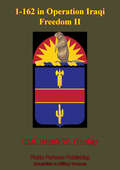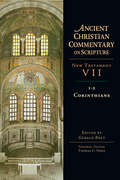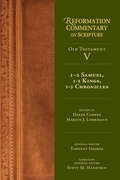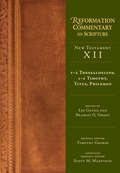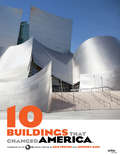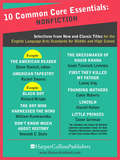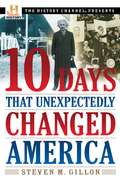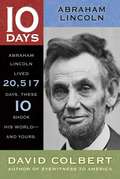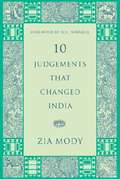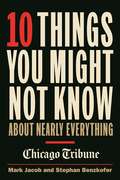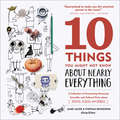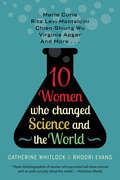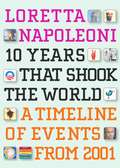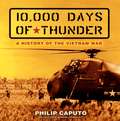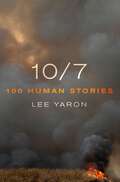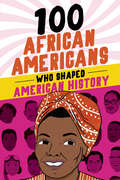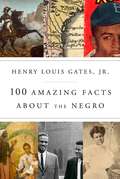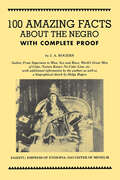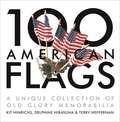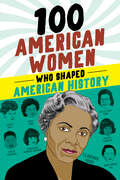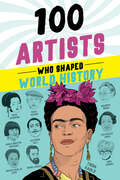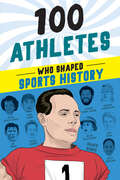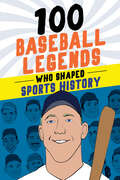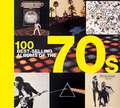- Table View
- List View
1-162 In Operation Iraqi Freedom II (Eyewitness To Modern War #5)
by CSM Brunk W. ConleyThis is a paper concerning the federal activation of the 2-162 IN battalion out of Oregon, their mobilization experience, deployment to Iraq in support of Operation Iraqi Freedom II, the redeployment back to Conus and Oregon, and the repercussions of the mission on the Soldiers as they reintegrated back into their families, jobs, and society.
1-2 Corinthians: New Testament (Ancient Christian Commentary on Scripture #7)
by Thomas C. Oden Gerald BrayPaul's letters to the Corinthian church have left a mark on Christian Scripture in a way that could never have been predicted. Here the pastoral issues of a first-century Christian community in what Chrysostom identified as "still the first city in Greece" stand out in bold relief. How was a community shaped by the cross to find its expression in a city that Chrysostom knew to be "full of orators and philosophers" and that "prided itself . . . above all on its great wealth"? How was church unity to be maintained in a setting where prominent believers, bending truth and morality to their own advantage, divided the body of Christ? Here lay the challenge for the apostle Paul. And as the apostle writes, the fathers lean over his shoulder, marveling and commenting on his pastoral wisdom. Best known among these patristic commentators is Chrysostom, whose seventy-seven homilies on the two Corinthian epistles are a treasury of exposition and application. The fragmentary works of Didymus the Blind and Severian of Gabala give us samples of Greek exegesis from the Alexandrian and Antiochene schools. The partial work of Theodore of Mopsuestia, a commentator of great skill and insight, was long valued in the church. And the comments of Theodoret of Cyrus are notable for their sensitivity to the intertextuality of Scripture. Then there are Origen and Pelagius, whose names resonate with notable error, to the needless obscuring of their brilliant insights into Scripture. But pride of place goes to the unknown fourth-century commentator long mistaken for Ambrose and now dubbed "Ambrosiaster." His excellent commentary on 1 and 2 Corinthians has been unavailable in English translation, and for that reason it is excerpted more generously in this volume. This Ancient Christian Commentary on 1-2 Corinthians opens a whole new way of reading these New Testament texts. The pastoral and theological interpretation of the fathers offers spiritual and intellectual sustenance to those who would read Paul again with open minds and hearts. Here we find the Pauline wisdom of the cross generating an effective heritage of Christian interpretation.
1-2 Samuel, 1-2 Kings, 1-2 Chronicles (Reformation Commentary on Scripture Series #5)
by Derek Cooper"Then David said to the Philistine, 'You come to me with a sword and with a spear and with a javelin, but I come to you in the name of the LORD of hosts.'" (1 Samuel 17:45) Reflecting upon David's victory over Goliath, Reformation translator, theologian and commentator William Tyndale compared it to Christ's victory over sin and death: "When David had killed Goliath the giant, glad tidings came to the Israelites that their fearful and cruel enemy was dead and that they were delivered out of all danger. For this gladness, they sang, danced and were joyful. In like manner, the good news or 'gospel' of God is joyful tidings." The books of 1-2 Samuel, 1-2 Kings and 1-2 Chronicles, which record the history of Israel from the prophetic ministry of Samuel to the fall of Jerusalem, provided the reformers with some of the best-known narratives of the Old Testament upon which to comment, including Hannah's prayer, the anointing of Saul as Israel's first king, David's triumph over Goliath and his later adultery with Bathsheba, Solomon's building of the Temple, Elijah's challenge to the prophets of Baal, and the healing of Naaman. For the reformers, these stories were not merely ancient Israelite history, but they also foreshadowed the coming of Jesus Christ, and they had immediate relevance for their lives and the church of their day. Thus, Anglican exegete John Mayer perceived within King Josiah's reform of Israelite worship after the discovery of the Book of the Law a prefiguration of "what should be done in the latter days of the gospel, in which a greater reformation of the religion is now being made." In this Reformation Commentary on Scripture volume, Derek Cooper and Martin Lohrmann guide readers through a diversity of Reformation commentary on these historical books. Here, readers will find reflections from both well-known voices and lesser-known figures from a variety of confessional traditions—Lutherans, Reformed, Radicals, Anglicans and Roman Catholics—many of which appear in English for the first time. By drawing upon a variety of resources—including commentaries, sermons, treatises and confessions—this volume will enable scholars and students to understand better the depth and breadth of Reformation-era insights on Scripture. It will also provide resources for contemporary preachers, and encourage all those who continually seek to share the "joyful tidings" of Jesus Christ.
1-2 Thessalonians, 1-2 Timothy, Titus, Philemon (Reformation Commentary on Scripture #Nt Volume 12)
by Bradley G. Green Lee Gatiss"Since we believe that Jesus died and rose again, even so, through Jesus, God will bring with him those who have fallen asleep." (1 Thess 4:14).
10 Buildings That Changed America
by Dan Protess Geoffrey Baer10 Buildings that Changed America tells the stories of ten influential works of architecture, the people who imagined them, and the way these landmarks ushered in innovative cultural shifts throughout our society. The book takes readers on a journey across the country and inside these groundbreaking works of art and engineering. The buildings featured are remarkable not only for aesthetic and structural reasons, but also because their creators instilled in them a sense of purpose and personality that became reflected in an overarching sense the American identity.Edited by the staff of WTTW, the Chicago PBS affiliate that is the most-watched public television station in the country, 10 Buildings will be released alongside the national broadcast of an hour-long special by the same name. This television event will be promoted over digital media, on-ground events, and educational initiatives in schools, and the book will be a significant component to all of these elements.10 Buildings retells the shocking, funny, and even sad stories of how these buildings came to be. It offers a peek inside the imaginations of ten daring architects who set out to change the way we live, work, and play. From American architectural stalwarts like Louis Sullivan and Frank Lloyd Wright, to modern revolutionaries like Frank Gehry and Robert Venturi, this book examines the most prominent buildings designed by the most noteworthy architects of our time.Also profiled are Americans less noted for their architectural acumen, but no less significant for their contributions to the field. Thomas Jefferson, a self-taught architect, is profiled for designing the iconic Virginia State Capitol. Taking its inspiration from ancient Rome, America's first major public building forged a philosophical link between America and the world's earliest democracies. Similarly, Henry Ford employed Albert Kahn to design a state-of-the-art, innovative factory for Ford's groundbreaking assembly line. Reinforced concrete supported massive, open rooms without any interior dividing walls, which yields the uninterrupted space that was essential for Ford's sprawling continuous production setups. What's more, Kahn considered the needs of workers by including astonishingly modern large windows and louvers for fresh air.The design of each of these ten buildings was completely monumental and prodigious in its time because of the architect's stylistic or functional innovations. Each was also highly influential, inspiring a generation or more of architects, who in turn made a lasting impact on the American landscape. We see the legacy of architects like Mies van der Rohe or H.H. Richardson all around us: in the homes where we live, the offices where we work, our public buildings, and our houses of worship. All have been shaped in one way or another by a handful of imaginative, audacious, and sometimes even arrogant individuals throughout history whose bold ideas have been copied far and wide. 10 Buildings is the ideal collection to detail the flashes of inspiration from these architects who dared to strike out on their own and design radical new types of buildings that permanently altered our environmental and cultural landscape.
10 Common Core Essentials: Selections from New and Classic Books for the English Language Arts Standards for Middle and High School
by Harper AcademicThe excerpts featured in this free sampler come from some of our most popular nonfiction books for middle and high school classrooms—making them ideal choices to meet the new Common Core Standards for the English Language Arts. From the primary documents of The American Reader to The Boy Who Harnessed the Wind—the story of young man from an impoverished African village who built a windmill to bring life-changing electricity to his community—these books will take students across time periods and around the world. They'll grapple with complex ideas and meet people from the past and present who will inspire them. Along the way, your students will come to understand the components of critical thinking and good writing—and why they matter.
10 Days That Unexpectedly Changed America
by Steven M. GillonA companion book to The History Channel's special series of ten one-hour documentaries, 10 Days That Unexpectedly Changed America pinpoints pivotal days that transformed our nation. For the series and the book, The History Channel challenged a panel of leading historians, including author Steven M. Gillon, to come up with some less well-known but historically significant events that triggered change in America. Together, the days they chose tell a story about the great democratic ideals upon which our country was built. It is a snapshot of our country as we were, are, and will be.
10 Days: Abraham Lincoln
by David ColbertYou're about to be an eyewitness to the ten crucial days in Abraham Lincoln's life, including: A tragic loss that sets a boy on a course for greatness. A career sacrificed to protest an unjust war. A state resorting to treason to preserve slavery. A president who learns the most difficult decisions are made alone. And a promise made to every citizen that American's salves will be free.
10 Judgements That Changed India
by Zia ModyHere are the Supreme Court s ten pivotal judgements that have transformed Indian democracy and redefined our daily lives. Exploring vital themes such as custodial deaths, reservations and environmental jurisprudence, this book contextualizes the judgements, explains key concepts and maps their impacts. Written by one of India s most respected lawyers, Ten Judgements That Changed India is an authoritative yet accessible read for anyone keen to understand India s legal system and the foundations of our democracy.
10 Things You Might Not Know About Nearly Everything
by Mark Jacob Stephan BenzkoferFor years, the Chicago Tribune's "10 Things You Might Not Know" column has been informing and entertaining readers on a diverse range of fascinating subjects. 10 Things You Might Not Know About Nearly Everything is a collection of the best of these columns, presented in a fun and easy-to-read format. This book gives readers well-researched, obscure facts on universal topics--including arts and culture, food and leisure, history, politics, science and technology, sports, holidays and religion, lifestyle, language, and more.10 Things You Might Not Know About Nearly Everything contains a plethora of surprising trivia and pertinent tidbits on so many different areas that will appeal to everyone from history buffs to sports fans to foodies, with an especially riveting look into Chicago-area history and facts. For example, in Zion, Illinois it was once not only illegal to gamble, curse, and sell alcohol and tobacco, but also to whistle on Sundays, put on plays, eat pork or oysters, spit, or wear tan-colored shoes.Some facts will make readers laugh and some will make jaws drop. This collection is a kaleidoscope of the absurd, the outrageous, and the sometimes-gruesome, making a highly entertaining mix of people, places, and things. 10 Things You Might Not Know About Nearly Everything will leave readers brighter, wittier, and curious to learn more about myriad worlds they never encountered before and will never forget.
10 Things You Might Not Know About Nearly Everything: A Collection of Fascinating Historical, Scientific and Cultural Trivia about People, Places and Things
by Mark Jacob Stephan Benzkofer Chicago TribuneA compendium of outrageous, hilarious or just plain shocking trivia about everything from history and politics to arts, religion, technology and much more. For years, the Chicago Tribune&’s &“10 Things You Might Not Know&” column has been informing and entertaining readers on a diverse range of subjects. This volume collects the best of these columns, offering readers obscure, fascinating facts on universal topics that will appeal to everyone from sports fans to history buffs, foodies, and more. Expertly researched and thoroughly entertaining, 10 Things You Might Not Know About Nearly Everything contains a plethora of surprising trivia on numerous topics, with an especially close look into Chicago-area history and facts. For example, in Zion, Illinois it was once illegal to spit, eat oysters, wear tan-colored shoes, or whistle on Sundays. 10 Things You Might Not Know About Nearly Everything will leave readers brighter, wittier, and curious to learn more about myriad subjects and stories they will never forget.
10 Women Who Changed Science and the World (Trailblazers, Pioneers, and Revolutionaries)
by Rhodri Evans Catherine WhitlockSpanning the nineteenth and twentieth centuries, this fascinating history explores the lives and achievements of great women in science across the globe. Ten Women Who Changed Science and the World tells the stories of trailblazing women who made a historic impact on physics, biology, chemistry, astronomy, and medicine. Included in this volume are famous figures, such as two-time Nobel Prize winner Marie Curie, as well as individuals whose names will be new to many, though their breakthroughs were no less remarkable. These women overcame significant obstacles, discrimination, and personal tragedies in their pursuit of scientific advancement. They persevered in their research, whether creating life-saving drugs or expanding our knowledge of the cosmos. By daring to ask &‘How?&’ and &‘Why?&’, each of these women made a positive impact on the world we live in today. In this book, you will learn about: AstronomyHenrietta Leavitt (United States, 1868–1921) discovered the period-luminosity relationship for Cepheid variable stars, which enabled us to measure the size of our galaxy and the universe. PhysicsLise Meitner (Austria, 1878–1968) fled Nazi Germany in 1938, taking with her the experimental results which showed that she and Otto Hahn had split the nucleus and discovered nuclear fission. Chien-Shiung Wu (United States, 1912–1997) demonstrated that the widely accepted &‘law of parity&’, which stated that left-spinning and right-spinning subatomic particles would behave identically, was wrong. ChemistryMarie Curie (France, 1867–1934) became the only person in history to have won Nobel prizes in two different fields of science. Dorothy Crowfoot Hodgkin (United Kingdom, 1910–1994) won the Nobel Prize for Chemistry in 1964 and pioneered the X-ray study of large molecules of biochemical importance. MedicineVirginia Apgar (United States, 1909–1974) invented the Apgar score, used to quickly assess the health of newborn babies. Gertrude Elion (United States, 1918–1999) won the Nobel Prize for Physiology or Medicine in 1988 for her advances in drug development. BiologyRita Levi-Montalcini (Italy, 1909–2012) won the Nobel Prize for Physiology or Medicine in 1986 for her co-discovery in 1954 of Nerve Growth Factor (NGF). Elsie Widdowson (United Kingdom, 1906–2000) pioneered the science of nutrition and helped devise the World War II food-rationing program. Rachel Carson (United States, 1907–1964) forged the environmental movement, most famously with her influential book Silent Spring.
10 Years That Shook the World: A Timeline of Events from 2001
by Loretta NapoleoniSeptember 11, 2001, is considered the main event, but the changes of the decade go far beyond the menace of terrorism and the war on terror. The technological revolution, the wide use of the Internet, and the advent of social media are just some of the innovations that grew to define the decade. The war on terror and its strong rhetoric hid these phenomena. The purpose of this book is to show the true patterns of change--those innovations that will influence coming decades. This is more than a timeline, it is the tale of an extraordinary decade. Within each year, Napoleoni presents events not in a strict chronology but more as we might remember them, often with the most significant events recalled first. Thus the main topics--politics, economics, people, technology, and the environment--cross over constantly, showing how they are all interlinked and how globalization is speeding up the pace of change in our world.
10,000 Days of Thunder: A History of the Vietnam War
by Philip CaputoIt was the war that lasted ten thousand days. The war that inspired scores of songs. The war that sparked dozens of riots. And in this stirring chronicle, Pulitzer Prize- winning journalist Philip Caputo writes about our country's most controversial war -- the Vietnam War -- for young readers. From the first stirrings of unrest in Vietnam under French colonial rule, to American intervention, to the battle at Hamburger Hill, to the Tet Offensive, to the fall of Saigon, 10,000 Days of Thunder explores the war that changed the lives of a generation of Americans and that still reverberates with us today. Included within 10,000 Days of Thunder are personal anecdotes from soldiers and civilians, as well as profiles and accounts of the actions of many historical luminaries, both American and Vietnamese, involved in the Vietnam War, such as Richard M. Nixon, General William C. Westmoreland, Ho Chi Minh, Joe Galloway, Dr. Martin Luther King Jr., Lyndon B. Johnson, and General Vo Nguyen Giap. Caputo also explores the rise of Communism in Vietnam, the roles that women played on the battlefield, the antiwar movement at home, the participation of Vietnamese villagers in the war, as well as the far-reaching impact of the war's aftermath. Caputo's dynamic narrative is highlighted by stunning photographs and key campaign and battlefield maps, making 10,000 Days of Thunder THE consummate book on the Vietnam War for kids.
10,000 Days of Thunder: A History of the Vietnam War
by Philip CaputoIt was the war that lasted ten thousand days. The war that inspired scores of songs. The war that sparked dozens of riots. And in this stirring chronicle, Pulitzer Prize- winning journalist Philip Caputo writes about our country's most controversial war -- the Vietnam War -- for young readers. From the first stirrings of unrest in Vietnam under French colonial rule, to American intervention, to the battle at Hamburger Hill, to the Tet Offensive, to the fall of Saigon, 10,000 Days of Thunder explores the war that changed the lives of a generation of Americans and that still reverberates with us today. Included within 10,000 Days of Thunder are personal anecdotes from soldiers and civilians, as well as profiles and accounts of the actions of many historical luminaries, both American and Vietnamese, involved in the Vietnam War, such as Richard M. Nixon, General William C. Westmoreland, Ho Chi Minh, Joe Galloway, Dr. Martin Luther King Jr., Lyndon B. Johnson, and General Vo Nguyen Giap. Caputo also explores the rise of Communism in Vietnam, the roles that women played on the battlefield, the antiwar movement at home, the participation of Vietnamese villagers in the war, as well as the far-reaching impact of the war's aftermath. Caputo's dynamic narrative is highlighted by stunning photographs and key campaign and battlefield maps, making 10,000 Days of Thunder THE consummate book on the Vietnam War for kids.
10/7: 100 Human Stories
by Lee YaronThe definitive account of the 10/7 attacks through the stories of its victims and the communities they called home.On October 7, 2023—the Sabbath and the final day of the holiday of Sukkot—the Gaza-based terror group Hamas launched an unprecedented assault on the people of Israel. Crashing through the border, attacking from the sea and air, militants indiscriminately massacred civilians in what became one of the worst terror attacks in modern history, and the most lethal day for the Jewish people since the Holocaust.A radically passionate work of investigative journalism and political critique by acclaimed Haaretz reporter Lee Yaron, 10/7 chronicles the massacre that ignited a war through the stories of more than 100 civilians. These stories are the products of extensive interviews with survivors, the bereaved, and first responders in Israel and beyond. The victims run the gamut from left-wing kibbutzniks and Burning Man-esque partiers to radical right-wingers, from Bedouins and Israeli Arabs to Thai and Nepalese guest workers, peace activists, elderly Holocaust survivors, refugees from Ukraine and Russia, pregnant women, and babies.At a time when people are seeking a deeper understanding of the history of the Israeli-Palestinian conflict and how internal political turmoil in Israel has affected it, they predominantly encounter perspectives from the powerful—from politicians and military officers. 10/7 takes a fresh approach, offering answers through the stories of everyday people, those who lived tenuously on the border with Gaza.Yaron profiles victims from a wide range of communities—depicting the fullness of their lives, not just their final moments—to honor their memories and reveal the way the attack ripped open Israeli society and put the entire Middle East on the precipice of disaster. Each chapter begins with a portrait of a community, interweaving history with broader political analysis of the Israeli-Palestinian conflict to provide context for the narratives that follow. Ultimately, 10/7 shows that the tragedy is much greater than the violence of the attacks, and in fact extends back through the entire Netanyahu era, which propagated a false image of Israel as a technologically advanced, militarily formidable powerhouse so essential to the region that it could continue to ignore and undermine Palestinian statehood indefinitely.
100 African Americans Who Shaped American History (100 Series)
by Chrisanne BecknerLearn all about the fascinating lives and tremendous impact of 100 extraordinary Black Americans with this fact-packed biography collection for kids 10 and up. Educational and engaging, 100 African Americans Who Shaped American History features:Simple, easy-to-read textIllustrated portraits of each figure Fascinating facts about famous and lesser-known Black heroesA timeline, trivia questions, project ideas and more!From Benjamin Banneker to Harriet Tubman, Duke Ellington to Rosa Parks, Malcolm X to John Lewis and many more, readers will be introduced to artists, activists, icons, ands legends throughout history. Organized chronologically, 100 African Americans Who Shaped American History offers a look at the prominent role these men and women played and how their talents, ideas, and expertise have influenced the country from its very beginning all the way through the present day.
100 Amazing Facts About the Negro
by Henry Louis GatesThe first edition of Joel Augustus Rogers’s now legendary 100 Amazing Facts About the Negro with Complete Proof, published in 1957, was billed as “A Negro ‘Believe It or Not.’” Rogers’s little book was priceless because he was delivering enlightenment and pride, steeped in historical research, to a people too long starved on the lie that they were worth nothing. For African Americans of the Jim Crow era, Rogers’s was their first black history teacher. But Rogers was not always shy about embellishing the “facts” and minimizing ambiguity; neither was he above shock journalism now and then. With élan and erudition—and with winning enthusiasm—Henry Louis Gates, Jr. gives us a corrective yet loving homage to Roger’s work. Relying on the latest scholarship, Gates leads us on a romp through African, diasporic, and African-American history in question-and-answer format. Among the one hundred questions: Who were Africa’s first ambassadors to Europe? Who was the first black president in North America? Did Lincoln really free the slaves? Who was history’s wealthiest person? What percentage of white Americans have recent African ancestry? Why did free black people living in the South before the end of the Civil War stay there? Who was the first black head of state in modern Western history? Where was the first Underground Railroad? Who was the first black American woman to be a self-made millionaire? Which black man made many of our favorite household products better? Here is a surprising, inspiring, sometimes boldly mischievous—all the while highly instructive and entertaining—compendium of historical curiosities intended to illuminate the sheer complexity and diversity of being “Negro” in the world.(With full-color illustrations throughout.)
100 Amazing Facts About the Negro with Complete Proof: A Short Cut to The World History of The Negro
by J. A. RogersWhite supremacy-busting facts that ran in the black publication the Pittsburgh Courier, written by the renowned African American author and journalist.First published in 1934 and revised in 1962, this book gathers journalist and historian Joel Augustus Rogers’ columns from the syndicated newspaper feature titled Your History. Patterned after the look of Ripley’s popular Believe It or Not the multiple vignettes in each episode recount short items from Rogers’s research. The feature began in the Pittsburgh Courier in November 1934 and ran through the 1960s.“I have been intrigued by this book, and by its author, since I first encountered it as a student in an undergraduate survey course in African-American history at Yale . . . Sometimes, [Rogers] was astonishingly accurate; at other times, he seems to have been tripping a bit, shall we say.” —Henry Louis Gates, Jr., The Root“Rogers made great contribution to publishing and distributing little know African history facts through books and pamphlets such as 100 Amazing Facts About the Negro with Complete Proof and The Five Negro Presidents . . . The common thread in Roger’s research was his unending aim to counter white supremacist propaganda that prevailed in segregated communities across the United States against people of African descent.” —Black History Heroes
100 American Flags: A Unique Collection of Old Glory Memorabilia
by Kit Hinrichs Delphine Hirasuna Terry HeffernanThe American flag has been raised high in wartime triumph and peacetime celebration; sewn lovingly onto quilts, caps, pillows, and bags; appropriated by popular culture; and faithfully honored every Fourth of July. This vibrant collection of 100 Stars and Stripes artifacts ranges from Civil War-era banners and Native American braided moccasins to an early 20th-century "friendship" kimono and original flag art by several of the world's leading designers. Destined to captivate folk-art aficionados, history buffs, and collectors, 100 AMERICAN FLAGS provides a stunning visual history of America's most treasured symbol. A timely, patriotic full-color book presenting 100 American flag artifacts from one of the world's most eminent collectors, designer Kit Hinrichs. Selected images from LONG MAY SHE WAVE in an affordable, collectible edition. Election year and wartime keepsake, displaying nonpartisan national pride. From the Hardcover edition.
100 American Women Who Shaped American History (100 Series)
by Deborah G. FelderLearn all about the fascinating lives and tremendous impact of 100 extraordinary women in America with this fact-filled biography collection for kids!Educational and engaging, this brand new edition of 100 American Women Who Shaped American History features:Simple, easy-to-read text that has been freshly updatedIllustrated portraits of each figureFascinating facts about famous and lesser-known women in historyA timeline, trivia questions, project ideas, and more!From Martha Washington to Rose Fortune, Gertrude Stein to Florence Price, Dolly Parton to Simone Biles and many more, readers will dive into the lives of 100 female artists activists, scientists, and icons who left their mark on history. Organized chronologically, this thoroughly researched biography collection offers a look at how the discoveries, talents, and ideas of these women have helped guide the country since its very beginnings.
100 Artists Who Shaped World History (100 Series)
by Barbara KrystalLearn all about the fascinating lives and tremendous impact of 100 extraordinary artists from around the world with this fact-filled biography collection for kids 8 and upThis easy-to-read biography collection includes:100 one-page biographies: Find out how artists from around the world made history!Illustrated portraits: Each biography includes an illustration to help bring history to life!A timeline, trivia questions, project ideas, and more: Boost your learning and test your knowledge with fun activities and resources!From Leonardo Da Vinci to Vincent van Gogh to Andy Warhol and many more, readers will be introduced to painters, sculptors, photographers throughout history. Organized chronologically, 100 Artists Who Shaped World History offers a look at how the lives, techniques, advancements, and great works of artists have influenced culture and society for thousands of years.
100 Athletes Who Shaped Sports History (100 Series)
by Russell Roberts Timothy JacobsThe collaborative effort of Timothy Jacobs and Russell Roberts, 100 Athletes Who Shaped Sports History is a compilation of one hundred single-page biographies summarizing the lives and achievements of great athletes ranging from Ted Williams, Patty Berg, and Sugar Ray Leonard, to Jackie Robinson, Michael Jordan, and Wayne Gretzky. A black-and-white photograph or a simple sketch of each of the great sports figures accompanies the brief narrative describing their role in the particular sport they embraced. 100 Athletes Who Shaped Sports History is recommended as a quick and easy read for sports trivia buffs, as well as being a great book to introduce young people to the varied and diverse world of sports legends.
100 Baseball Legends Who Shaped Sports History (100 Series)
by Russell RobertsLearn all about the amazing lives and careers of 100 of the greatest baseball players of all time with this fact-filled biography collection for kids. Educational and engaging, 100 Baseball Legends Who Shaped Sports History features:Simple, easy-to-read, and freshly updated textIllustrated portraits of each playerFascinating facts and statsA timeline, trivia questions, project ideas and more!From Cy Young to Lou Gherig, Jackie Robinison to Hank Aaron, George Brett to Derek Jeter and many more, readers will be introduced to the lives and feats of the greatest athletes ever to play baseball. Organized chronologically, 100 Baseball Legends Who Shaped Sports History offers a look at the amazing talent and skill of these players and how their accomplishments and careers have influenced the sport from its very beginnings all the way through the present day.
100 Best-selling Albums of the 70s
by Hamish ChampFrom the Bee Gees to Pink Floyd to Supertramp, you’ll love this stroll down memory lane!From singer-songwriters like Billy Joel and the Bee Gees to folk artists like John Denver and James Taylor to the rock legends Aerosmith and Led Zeppelin, you won’t find a more complete list of albums that defines the '70s music scene. Each listing features the full-color, original sleeve artwork, and is packed with information about the musician lineup, track listings, and number-one singles that resulted. A celebration of this funky era, this book will help you shake your groove thing!
